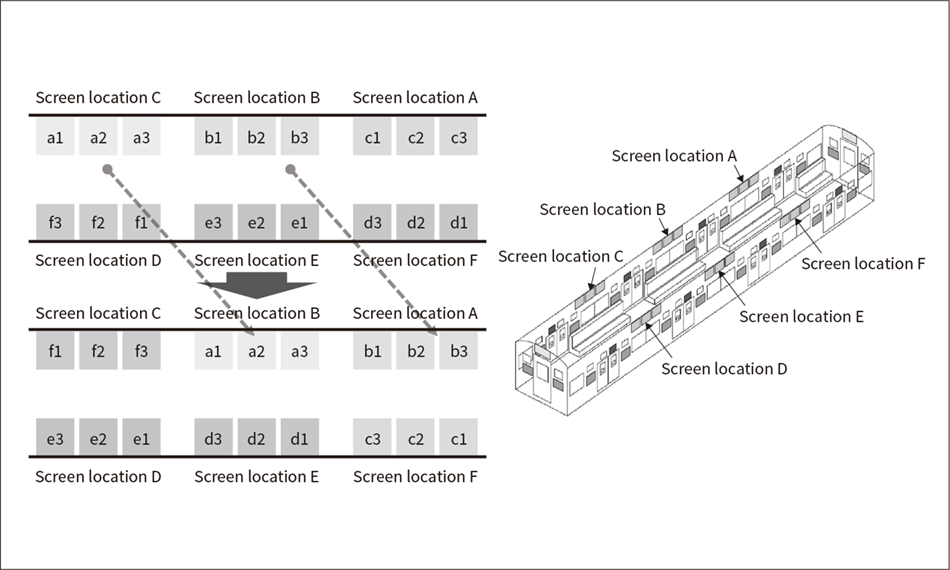[ⅳ]Information and Control Systems for Railway Industry
Hitachi has contributed to DX in the railway industry and the provision of information to passengers by developing a smart LCD display unit that uses the autonomous decentralized architecture previously adopted for traffic management applications. Development of the on-board passenger information display began in earnest in 2006. The display features high utilization rate, delivers information that takes account of the user experience by helping allay passenger anxiety about where to get off the train, provides high-quality display advertising in a way that caters to the needs of advertisers, and incorporates maintenance functions designed to eliminate human error by maintenance staff and reduce their workloads. This article describes Hitachi’s work on this on-board passenger information display and how it has contributed to DX in the railway industry.





Figure 1 — On-board Passenger Information Display Installed over Door on Series E235 Rolling Stock of East Japan Railway Company (Yokosuka Line) The 21.5-inch full high-definition (FHD) liquid crystal display (LCD) unit presents passenger information (right screen) and advertising (left screen).
The 21.5-inch full high-definition (FHD) liquid crystal display (LCD) unit presents passenger information (right screen) and advertising (left screen).
Railway operators have been reforming their businesses over recent years, embarking on the digital transformation (DX) of past practices as they work to deliver passenger services that are safer and more secure, comfortable, and convenient. On-board route information and advertising has in the past been provided in the form of print media, with any real-time updates such as schedule changes being conveyed to passengers by means of public announcements from the on-board staff. Subsequently, the Law for Promoting Easily Accessible Public Transportation Infrastructure for the Aged and the Disabled (the “Transportation Barrier-Free Law”) was enforced in 2006, with improved information provision to passengers among its aims. This led to the publication of guidelines based on this law [the Transportation Facilitation Maintenance Guidelines for Public Transportation (Passenger Facility Edition and Vehicles, etc. Edition)](1) and the installation of on-board passenger information displays in trains (see Figure 1). These liquid crystal display (LCD) units used in place of print media can display advertising and route information that can be updated as the situation changes. The on-board passenger information displays serve as enablers for DX and Hitachi has been supplying the equipment since development commenced in 2006(2).
This article describes the work being done by Hitachi on these on-board passenger information displays that have helped the railway industry achieve DX in on-board route display design, advertising, and the maintenance of display equipment and content.
Figure 2 — Block Diagram of On-board Passenger Information Display System The on-board passenger information display is made up of a host system, client units, smart LCD display units, and an on-board WiMAX unit.
The on-board passenger information display is made up of a host system, client units, smart LCD display units, and an on-board WiMAX unit.
The on-board passenger information display is made up of a host system, client units, smart LCD display units, and an on-board WiMAX* unit (see Figure 2). A feature of the Hitachi system is its use of an autonomous decentralized architecture in which each unit has its own central processing unit (CPU)(2). This configuration allows each unit within the system to operate autonomously so that the system as a whole can remain in operation even if individual units drop out or while new units are being retrofitted.
The guidelines referred to above stipulate the installation, in prominent locations in the train, of LCD, light-emitting diode (LED), or similar display units for the benefit of people with hearing or other impairments so that they can provide essential information in visual form (text and graphics), including the next stop, final stop, and whether the train is an express service, etc. Other recommendations in the guidelines include the use of a large font to make text easier to read, the use of text to indicate when the train needs to be evacuated, and the presentation of information in a way that is easy to understand. To satisfy these requirements, Hitachi improved legibility by enlarging the size of the LCD screens from 17 to 21.5 inches and upgrading their resolution from wide extended graphics array (WEGA) to full high definition (FHD). The section below on DX initiatives describes how Hitachi has gone about presenting information during abnormal situations and designing screens for greater legibility.
In keeping with the emerging digital way of life, the low-cost availability of large data storage devices has made it easy to store large amounts of content on the LCD display unit. Meanwhile, WiMAX2+ has dramatically improved the performance of communications between on-board and off-board systems, enabling the high-speed transmission of large amounts of content to multiple rolling stock.
What railway operators require from advertising has evolved over time. While installing LCD screens above train doors and using print advertising above the windows was common in the past, recent years have seen rising demand for locating three-screen LCD units above the windows for advertising use. Especially in the case of over-window advertising, LCD screens attract more attention from passengers than print media, with market research reports indicating that the former are among the most effective of all the many different forms of advertising(3). Hitachi has been developing a wide variety of promotional display functions, with the ability to add an individual client unit without affecting the existing architecture making it possible to position three-screen advertising LCD units above the windows (see Figure 3). This work is described in greater detail below.
Figure 3 — Over-window Installation of Three Display Screens on Series E235 Rolling Stock of East Japan Railway Company (Yamanote Line) The three 21.5-inch FHD LCD display units are installed above the windows and used for a wide variety of advertising.
The three 21.5-inch FHD LCD display units are installed above the windows and used for a wide variety of advertising.
The computerization associated with the switch from print media to LCD screens for on-board route display and advertising also created a need for system maintenance, including monitoring for faults and the updating of equipment settings and software.
The two ways of installing LCD units in a train are to fit them at designated locations that have already been specified in the display units, or to install LCD units that have yet to be so configured and then update them later with the relevant location settings. Whichever method was used, a time-consuming post-installation check of the units’ configuration settings and location was performed to identify and resolve any human errors such as incorrect settings or installation.
Similarly, the two ways of updating software are to do this by means of a physical change, such as by replacing a read-only memory (ROM), or by going around the units with a maintenance terminal and connecting to each one in turn to perform the update. Both methods are very labor-intensive for systems that have a large number of devices, posing issues for recruitment and training of maintenance staff. Another issue was that software upgrades could not be performed when trains were in service, requiring rolling stock schedules to be adjusted and allowing only limited time to perform the work.
When a fault occurred on in-service rolling stock, the driver or conductor would be notified by an alarm sent to the driver’s cab. The problem with this, however, is that the collective priority of faults on equipment that does not impact the running of the train is low and so it can take some time until maintenance staff respond.
Hitachi has been developing functions intended to overcome these challenges for maintenance staff. This work is described in greater detail below.
To comply with the guidelines derived from the Transportation Barrier-Free Law, and in anticipation of rising numbers of overseas visitors to Japan, what is needed are flexible and fine-grained ways of providing information so that all sorts of different people can travel in safety and confidence. For abnormal situations in particular, this calls for the ability to provide information specific to the train concerned as well as for the line as a whole (see Figure 4).
This section describes the display of information based on user experience (UX) design considerations aimed at allaying passenger anxiety about getting to their destination.
In the past, passengers would refer to the overhead route maps provided in railway carriages to find their way to their desired destination. While these printed route maps had the benefit of showing the entire railway network, the disadvantage was the time it took passengers to identify their own railway line on the map. Moreover, these printed route maps posed an obstacle to people such as the elderly who find it difficult to read small print or overseas visitors unfamiliar with Japanese. Fortunately, the addition in recent years of smart LCD display units has facilitated the provision of real-time information to passengers about the service they are currently using. It has also enabled the barrier-free provision of information through measures such as varying the size and color of text to indicate its importance or displaying information in other languages. This also contributes to provision of information in ways that meet the needs of a wide range of users by doing so in ways that are tailored to the particular line, whether it be circle lines such as the Yamanote Line operated by East Japan Railway Company (see Figure 5), details of facilities at major stations (see Figure 6), Green Car (first class) services such as those available on the Yokosuka Line (see Figure 7), or information about branch lines (see Figure 8).
Figure 4 — Disruption Notification on Series E235 Rolling Stock of East Japan Railway Company (Yamanote Line) Revisions to the Transportation Barrier-Free Law stipulate that information be provided about the situation of the current train, not just the status of the overall network. The design makes use of four different languages in consideration of overseas visitors who often feel very anxious when something out of the ordinary occurs such as a train halting between stations.
Revisions to the Transportation Barrier-Free Law stipulate that information be provided about the situation of the current train, not just the status of the overall network. The design makes use of four different languages in consideration of overseas visitors who often feel very anxious when something out of the ordinary occurs such as a train halting between stations.
Figure 5 — Display of Upcoming Stations on Series E235 Rolling Stock of East Japan Railway Company (Outer Loop of Yamanote Line) The circular Yamanote Line uses the terms “inner loop” and “outer loop” for the counterclockwise and clockwise services, respectively. The design provides passengers with an intuitive indication of the direction of travel that is visible to them as soon as they get on the train.
The circular Yamanote Line uses the terms “inner loop” and “outer loop” for the counterclockwise and clockwise services, respectively. The design provides passengers with an intuitive indication of the direction of travel that is visible to them as soon as they get on the train.
Figure 6 — Display of Station Facilities on Series E235 Rolling Stock of East Japan Railway Company (Yamanote Line) As a primary travel artery in Tokyo, the Yamanote Line stops at hub stations that connect to other major railway lines, many of which have a complex array of facilities. Accordingly, the design uses icons to represent station facilities and to provide passengers with an intuitive indication of how to proceed after the train arrives at the station.
As a primary travel artery in Tokyo, the Yamanote Line stops at hub stations that connect to other major railway lines, many of which have a complex array of facilities. Accordingly, the design uses icons to represent station facilities and to provide passengers with an intuitive indication of how to proceed after the train arrives at the station.
Figure 7 — Display of Upcoming Stations on Series E235 Rolling Stock of East Japan Railway Company [Yokosuka Line Green Car (First Class)]![Figure 7 — Display of Upcoming Stations on Series E235 Rolling Stock of East Japan Railway Company [Yokosuka Line Green Car (First Class)]](/rev/archive/2021/r2021_05/05a09/image/fig_07.png) As passengers on Yokosuka Line Green Car (first class) services sit on forward-facing seats with LCD display units mounted perpendicular to the direction of travel, the design uses a vertical representation of the track map. The font size is also chosen so as to be clearly visible from the rear of the carriage.
As passengers on Yokosuka Line Green Car (first class) services sit on forward-facing seats with LCD display units mounted perpendicular to the direction of travel, the design uses a vertical representation of the track map. The font size is also chosen so as to be clearly visible from the rear of the carriage.
The transition from printed to electronic (LCD) formats as the primary means of displaying on-board advertising means that video can now be used to show more diverse content. Meanwhile, along with all the many and various video formats, there has been demand from advertisers to re-use existing commercials. For this reason, Hitachi’s display units support multiple mainstream formats such as MPEG-2 and H.264. Advertising value is also enhanced by the ability to mix different formats seamlessly. With the requirements of advertisers having become more sophisticated and diverse in recent years, this section describes eye-catching display techniques for meeting these needs.
Figure 9 — Three-screen Display Unit Locations and How Advertisements are Sequenced The display of advertising content is sequenced in a way that increases opportunities for viewing by passengers, with six different advertisements playing at one time by offsetting their display timing across each of the six screen locations (A to F).
The display of advertising content is sequenced in a way that increases opportunities for viewing by passengers, with six different advertisements playing at one time by offsetting their display timing across each of the six screen locations (A to F).
Hitachi’s smart LCD display units have an autonomous decentralized configuration that allows them to operate independently of each other. Hitachi has taken advantage of this to develop a technique for coordinating the display of advertising across three LCD screens at a time. This makes it possible to treat three LCD units as a single screen and display a wide variety of animated content to passengers featuring text or images that are too large to fit on a single screen.
The three-screen LCD units can show material from multiple locations inside the train (see Figure 9), with the ability to specify the advertising display sequence for each location separately. Railway operators can take advantage of this function to offset the sequencing of advertising display and thereby run six sets of advertisements at a time. Passengers, meanwhile, can watch whichever of the advertisements interest them, without having to change seats.
By making use of a technique provided by the smart LCD display units for optimizing when to display advertising based on train operation (current location and time), railway operators have been able to attract a wide range of advertisers and meet their increasingly diverse needs. These train-specific details can also include urgent information such as during an emergency. Whereas, in the past, urgent information like this was normally only displayed on the information screens, Hitachi has upgraded its system to allow for display on advertising screens also. This can guide passenger behavior by ensuring that they are alerted to important safety-related notifications.
To address the maintenance-related issues discussed earlier, such as human error and the time taken to perform work, Hitachi has developed three new functions, namely auto-detection of installation location, remote loading, and fault reporting.
The auto-detection function takes advantage of the autonomous decentralized configuration whereby each unit has its own CPU to automatically identify unit location after installation. This means that installers do not need to take note of where they install the units, avoiding system rework due to human errors such as incorrect settings or location.
Remote loading is a function for using the on-board data network to update the software on the remote units from the host system. Trains can have 300 or more such units that need to be updated together and the system can use this function to load new software efficiently, even when the time available for doing so is limited. Moreover, as software can also be loaded onto in-service trains by means of a WiMAX connection to off-board systems, software updates can be done without any disruption to operating schedules.
Fault reporting, meanwhile, uses a WiMAX connection to send a notification e-mail containing information about any equipment fault that occurs. This shortens the time taken to respond to faults and reduces the duration of any equipment outages. It also helps to improve the efficiency of maintenance and operation by providing the ability to invoke information collection remotely from the off-board system, including things like advertising records, LCD screenshots, and operation logs.
This article has described how Hitachi is using its on-board passenger information display to achieve DX.
Railway operators are seeking to realize the ideal of the “smart train,” making qualitative reforms on a variety of fronts, including their operations and services(4).
Together with progress on automated operation, work toward making smart trains a reality extends beyond the rolling stock itself, with changes to how drivers, conductors, and other on-board staff go about their work also being investigated. In particular, this includes trialing ways in which the system can assist with work traditionally done by conductors or other human staff in order to establish working practices compatible with a falling population(5).
In their transportation services, operators are also seeking to provide a travel environment and route network with high added value that suits the needs of passengers for enjoyable, comfortable, and convenient transportation(4).
Hitachi intends to continue developing the on-board passenger information display described in this article and making it available as a means of overcoming the challenges facing railway operators. Hitachi also intends to continue its pursuit of safety, security, comfort, and convenience through the development of better products.
The authors would like to take this opportunity to express their sincere thanks to all of the people from East Japan Railway Company and JR East Marketing & Communications, Inc. (Jeki) who provided considerable assistance with this work.